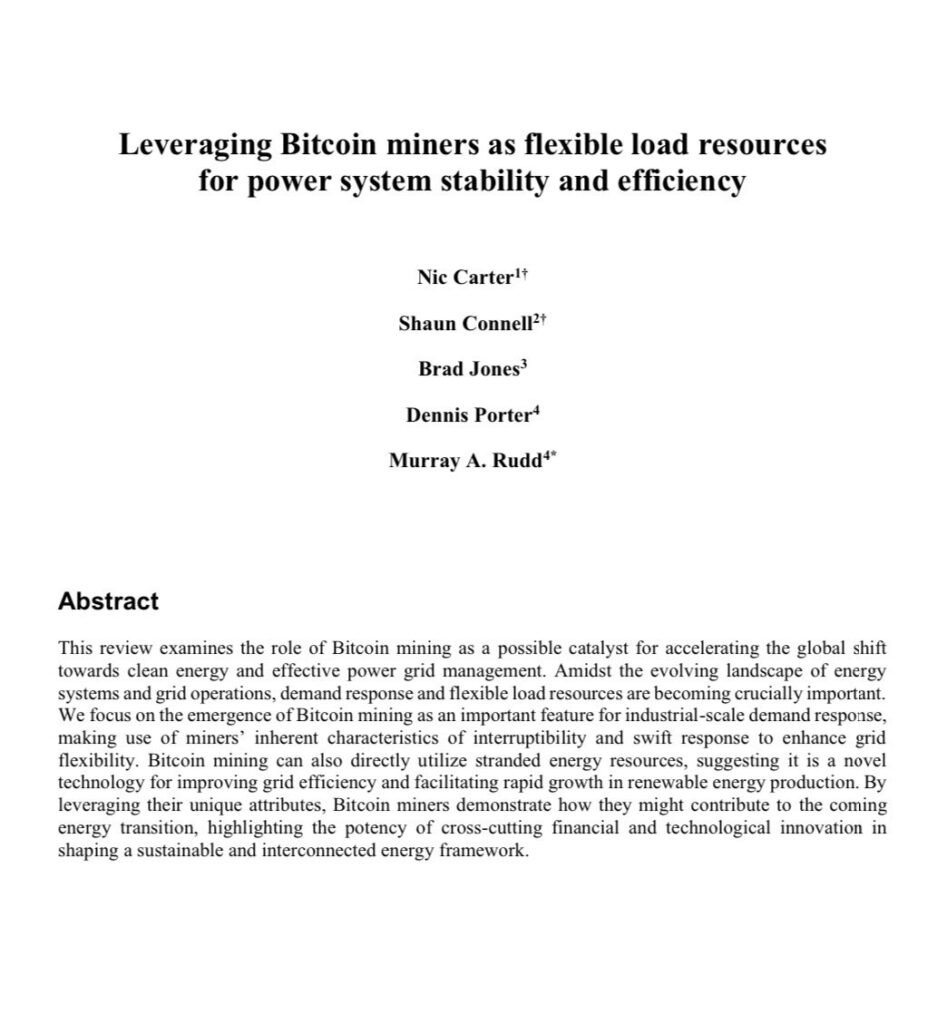A recent paper authored by prominent figures in the Bitcoin community and the former president of the Electric Reliability Council of Texas (ERCOT) states that bitcoin mining is not only a vital tool for clean energy but also a key player in grid stability.
This Bitcoin mining clean energy report was published on November 22, titled “Leveraging Bitcoin Miners as Flexible Load Resources for Power System Stability and Efficiency.” The report explores the potential of bitcoin to facilitate the integration of renewable energy.
Bitcoin Mining Clean Energy and Enhanced Grid Flexibility
The authors of the paper include Nic Carter of Castle Island Ventures, Dennis Porter, CEO of Satoshi Action Fund, Murray Rudd, a science adviser, Shaun Connell, executive VP of Power at Lancium, and the late Brad Jones, former ERCOT president and CEO.
They argue that Bitcoin mining’s inherent interruptibility and fast load response capabilities can significantly enhance grid flexibility. This improvement, they propose, is crucial for the seamless integration of variable renewable energy sources into the power system.

Case studies presented in the paper highlight instances of Bitcoin miners actively participating in demand response programs and providing grid services in Texas. These real-world examples illustrate the unique ability of Bitcoin miners to function as flexible and controllable loads, contributing to the technical and economic stability of the grid.
The paper highlights the modest infrastructure demands of Bitcoin mining, predominantly relying on electricity and specialized ASIC hardware, adding:
“Miners possess the latitude to explore energy sources beyond traditional grids and internet infrastructure. This strategic positioning becomes feasible in the presence of accessible and low-cost energy sources and Starlink internet connections.”
The findings of this paper directly challenge the narrative propagated by anti-bitcoin politicians who accuse Bitcoin miners of causing high energy usage and straining grids. Notably, the paper suggests that Bitcoin miners can play a pivotal role in demand response, countering claims of environmental impact.
Related reading: Bitcoin is ESG Compliant: A KPMG Report
Bitcoin mining pioneer Marshall Long recently shared the study on X and rebutted October 2022’s claims by U.S. Senator Elizabeth Warren and other Democrats who pressed ERCOT for information on Bitcoin mining electricity consumption. Long stated that those who operate the grids dispute the allegations, challenging the anti-bitcoin stance.
Recent Studies Support the Paper
This study resonates with a report by Fidelity Digital Assets, released earlier this month. The report claims that most of the mining operations are powered by renewable energy, or energy that would otherwise be wasted.
Similarly, a Cornell University study published in October adds weight to the argument by demonstrating how wind and solar projects can benefit from bitcoin mining during their pre-commercial development phases. This synergy between digital asset mining and renewable energy projects marks a positive step towards sustainability.
As bitcoin halving approaches, bitcoin miners are witnessing record-high revenue, reaching an average daily revenue of around $32 million over the past month. The hashrate, a key indicator of computational power in bitcoin mining, has also reached record levels, indicating the deployment of more powerful computers by the miners. Moreover, the anticipation of approval for a Spot ETF has further fueled bitcoin’s recent rally, sending the price to around $38,000.
Related reading:










